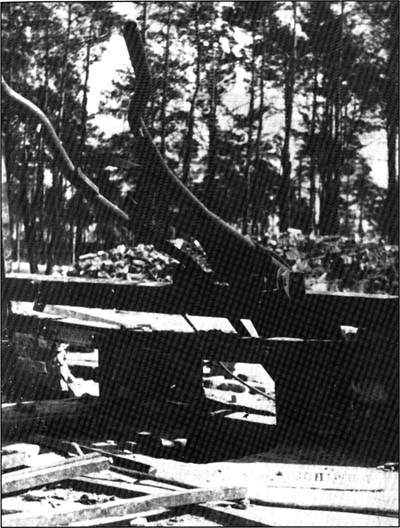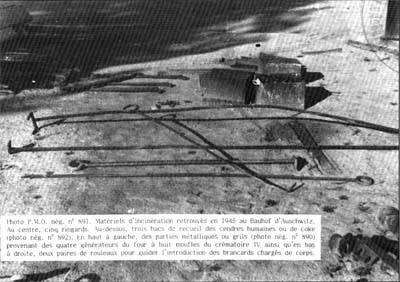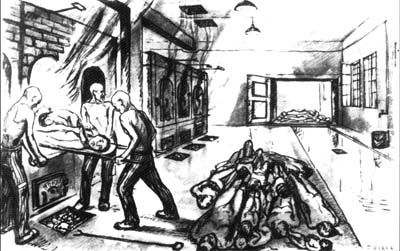| these convoys. Just before the arrival of the Hungarian transports, he ordered pits to be dug alongside Krematorium V [Document 39] and restarted the activity of Bunker 2, which had been lying idle, and its pits. In the yard of the Krematorium, there were notices on posts. with inscriptions telling the new arrivals from the transports that they were to go to the camp where work was waiting for them, but that first they had to take a bath and undergo disinfestation. For that, it was necessary for them to undress and put all their valuables in baskets specially placed for this purpose in the yard. Moll repeated the same thing in his speeches to the new arrivals. There were so many convoys that sometimes it happened that the gas chambers were incapable of containing all the new arrivals. The excess people were generally shot, one at a time. On several occasions, Moll threw people into the flaming pits alive. He also practised shooting people from a distance [see David Olère’s sketch, Document 40, associating these two practices]. He ill-treated and beat the Sonderkommando prisoners, treating them like animals. Those who were in his personal service told us that he used a piece of wire to fish out gold objects from the box containing the jewels taken from new arrivals, and took them off in a briefcase. Among the objects left by the people who came to be gassed, he took furs and different types of food, in particular fat. When he took food, he said smilingly to the SS around him that one had to take advantage before the lean years came. Under his direction, the Sonderkommando was strengthened and increased to about 1000 prisoners. When I arrived in the Sonderkommando, it comprised only about 400 men. a number that was maintained until January or February 1944. It was at this time that a convoy of about 300 of its members was sent to Lublin [Maidanek]. Before I arrived in the Sonderkommando, about 50 prisoners a week were regularly added to it. Despite these constant additions. many died and there were no more than 400 prisoners in it when I started to work there. After the convoy departed for Lublin, there were one hundred of us left. They then sent us 20 Russians and a German, called Karol, as Capo. The Sonderkommando also received several dozen prisoners, among others gold founders [Goldgiesser] and the “stokers” of Auschwitz Krematorium I, so that in April 1944. the Sonderkommando comprised about 160 prisoners. At the end of the |
|
 |
Document 36:
[PMO neg. no. 859]
Ruins of the 8-muffle furnace of Krematorium V, northwest corner, photographed in 1945-46, with, a “Leichenbrett” (metal corpse-charging stretcher) resting on its rollers. At ground level, two lower openings where the [human] ash bins were placed. In the background, the debris of the building, carefully heaped up. |
|
| Document 37 |
 |
|
| |
Document 37
[PMO neg. no. 891] |
| |
Krematorium equipment found in the Auschwitz Bauhof in 1945. |
| |
Center: Five fire irons |
| |
Above: Three bins for receiving human or coke ashes (neg. no. 892) |
| |
Upper left: Metal parts or fire bars (neg. no. 890) from the four fire-boxes of the 8-muffle furnace of Krematorium IV |
| |
Bottom right: Two pairs of rollers for supporting the metal stretchers used to charge the corpses |
|
 |
Document 38 |
|
| Document 38: |
|
| Sketch by David Olère, dating from 1945, showing the furnace room of Krematorium III, with three prisoners charging corpses loaded on a stretcher, using a technique slightly different front that described by Henryk Tauber. The pair of movable rollers visible on the end furnace is unused and replaced by an iron bar or piece of wood to guide and take the weight of the stretcher. Note the faithful representation of the fire irons used. |
|
|

